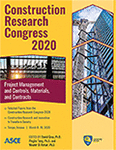Construction Research Congress 2020
Relationship between Stocks of Construction Companies and the Gross Domestic Product in the U.S.
Publication: Construction Research Congress 2020: Project Management and Controls, Materials, and Contracts
ABSTRACT
There is a sizeable amount of research that investigates the relationship between the construction market and the economy. However, the impact of key companies in the construction market on the economic performance still requires more research. The goal of this research is to investigate the connection between the GDP, as a measure of the economic performance, and the stock prices of large publicly traded companies in the construction industry, in the U.S. This is achieved by analyzing the GDP, total construction spending (TTLCONS), S&P 500 Index (GSPC), and the stocks of large companies in the construction field. The analysis methods include: 1) statistical analysis using correlation analysis and Granger causality testing, and 2) vector auto-regression (VAR). Analysis is performed using R. Preliminary results show positive correlations between the GDP, TTLCONS, GSPC, and the stock prices. Granger causality testing showed a satisfactory causality of the stock prices on the GDP. A VAR model was developed and used to predict the GDP for the coming two years. In order to validate the VAR model, it was fitted for historical data before the year 2008 and tested for its ability to predict the 2008 economic crisis. The model correctly predicted the crisis within a satisfactory level of accuracy. This research proposes the significance of investigating the effect of key players in construction on the economy. It presents a new perspective on the relationship between the construction market and economic performance.
Get full access to this article
View all available purchase options and get full access to this chapter.
ACKNOWLEDGEMENT
The authors would like to thank Dr. Charles B. Sims, Associate Professor of Economics and Faculty Fellow at the Baker Center for Public Policy at the University of Tennessee in Knoxville, for providing valuable guidance and insights that helped shape this research in its current form.
REFERENCES
Anaman, K. A., and Osei-Amponsah, C. (2007). “Analysis of the causality links between the growth of the construction industry and the growth of the macro-economy in Ghana.” Construction Management and Economics, 25(9), 951–961.
Barber, Herbert, and El-Adaway Islam. (2014). “U.S Economic Indicators and Stock Prices of Construction Equipment Manufacturers: A Statistical Relationship Analysis.” Construction Research Congress 2014, Proceedings.
Bayar, Y., Kaya, A., and Yildirim, M. (2014). “Effects of Stock Market Development on Economic Growth: Evidence from Turkey.” International Journal of Financial Research, 5(1).
Diewert, W. E., Nakamura, A. O., and Nakamura, L. I. (2009). “The housing bubble and a new approach to accounting for housing in a CPI.” Journal of Housing Economics, Special Issue on Owner Occupied Housing in National Accounts and Inflation Measures, 18(3), 156–171.
Foresti, P. (2006). “Testing for Granger Causality Between Stock Prices and Economic Growth.” 11.
Green, R. K. (1997). “Follow the Leader: How Changes in Residential and Non-residential Investment Predict Changes in GDP.” Real Estate Economics, 25(2), 253–270.
Honek, K., Azar, E., and Menassa, C. C. (2012). “Recession Effects in United States Public Sector Construction Contracting: Focus on the American Recovery and Reinvestment Act of 2009.” Journal of Management in Engineering, 28(4), 354–361.
Hyndman, R., Athanasopoulos, G., Bergmeir, C., Caceres, G., Chhay, L., O’Hara-Wild, M., Petropoulos, F., Razbash, S., Wang, E., and Yasmeen, F. (2018). forecast: Forecasting functions for time series and linear models.
Hyndman, R. J., and Khandakar, Y. (2008). “Automatic time series forecasting: the forecast package for R.” Journal of Statistical Software, 26(3), 1–22.
Lopes, J., Nunes, A., and Balsa, C. (2011). “The long-run relationship between the construction sector and the national economy in Cape Verde.” International Journal of Strategic Property Management, 15(1), 48–59.
Lütkepohl, H., Krätzig, M., and Phillips, P. C. B. (2004). Applied Time Series Econometrics. Cambridge University Press.
Pearson, K. (1895). “Note on Regression and Inheritance in the Case of Two Parents.” Proceedings of the Royal Society of London, 58, 240–242.
Pfaff, B. (2008a). Analysis of Integrated and Cointegrated Time Series with R. Springer, New York.
Pfaff, B. (2008b). “VAR, SVAR and SVEC Models: Implementation Within R Package vars.” Journal of Statistical Software, 27(4).
R Core Team. (2018). R: A Language and Environment for Statistical Computing. R Foundation for Statistical Computing, Vienna, Austria.
Reinhart, A. (2017). pdfetch: Fetch Economic and Financial Time Series Data from Public Sources.
RStudio Team. (2015). RStudio: Integrated Development Environment for R. RStudio, Inc., Boston, MA.
Ryan, J. A., and Ulrich, J. M. (2018). xts: eXtensible Time Series.
Strauss, J. (2013). “Does housing drive state-level job growth? Building permits and consumer expectations forecast a state’s economic activity.” Journal of Urban Economics, 73(1), 77–93.
U.S. Bureau of Economic Analysis. (2018). “Gross Domestic Product.” FRED, Federal Reserve Bank of St. Louis, https://fred.stlouisfed.org/series/GDP (Nov. 19, 2018).
U.S. Bureau of the Census. (2018). “Total Construction Spending.” FRED, Federal Reserve Bank of St. Louis, https://fred.stlouisfed.org/series/TTLCONS (Nov. 19, 2018).
Zeileis, A., and Grothendieck, G. (2005). “zoo: S3 Infrastructure for Regular and Irregular Time Series.” Journal of Statistical Software, 14(6), 1–27.
Information & Authors
Information
Published In
Construction Research Congress 2020: Project Management and Controls, Materials, and Contracts
Pages: 574 - 582
Editors: David Grau, Ph.D., Arizona State University, Pingbo Tang, Ph.D., Arizona State University, and Mounir El Asmar, Ph.D., Arizona State University
ISBN (Online): 978-0-7844-8288-9
Copyright
© 2020 American Society of Civil Engineers.
History
Published online: Nov 9, 2020
Authors
Metrics & Citations
Metrics
Citations
Download citation
If you have the appropriate software installed, you can download article citation data to the citation manager of your choice. Simply select your manager software from the list below and click Download.
